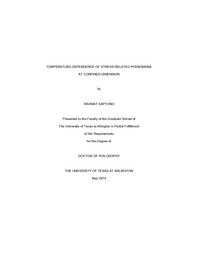
ATTENTION: The works hosted here are being migrated to a new repository that will consolidate resources, improve discoverability, and better show UTA's research impact on the global community. We will update authors as the migration progresses. Please see MavMatrix for more information.
Show simple item record
| dc.contributor.author | Saptono, Rahmat | en_US |
| dc.date.accessioned | 2014-07-14T20:34:31Z | |
| dc.date.available | 2014-07-14T20:34:31Z | |
| dc.date.issued | 2014-07-14 | |
| dc.date.submitted | January 2014 | en_US |
| dc.identifier.other | DISS-12726 | en_US |
| dc.identifier.uri | http://hdl.handle.net/10106/24506 | |
| dc.description.abstract | Efforts have been made to develop a simple but physically sound model. The model was specifically proposed to capture, explain, and estimate the temperature sensitivity and strengthening mechanism phenomena in small volume material with particular reference to the roles grain boundary and surface. Model-inspired phenomenology approach was applied to reveal the key mechanisms and find directions for a more complete constitutive model. The model was developed in the limited space where diffusion is insignificant. It was assumed that the plastic flow was predominantly governed by the thermally-activated process of dislocation glide overcoming barriers. Simple mathematical functions were formulated and evaluated to model the behavior. The figures of merit functions were fitted into the experimental data to evaluate physical parameters. Normalization was performed prior to the regression analysis to extract real variables and allow global evaluation. Behavior of the small volume materials subjected to temperature variation within the range of argument can be generally condensed, described and predicted by an exponential decay model. In particular, the models are able to explain the responsible mechanism behind the observed phenomena. Important findings had been concluded through the model application along with simplified observation and analysis. Surface is not a part of main strengthening mechanism. Thin film exhibits atypical high flow stress because of high density grain boundary and dislocation density, which is a true effect of confinement. Grain boundary strengthening becomes weaker and mechanism becomes short-range in thin films with small grains. Exponential decay model explains the temperature-dependence of flow stress behavior in small volume metallic materials with physical validity. The validity is proven by finding a direct connection of the model to the established physical mechanistic model in the field. Despite of quite a few limitations, it provides directions for more complete and advanced constitutive equations and guidance for further investigations through physical experiment. | en_US |
| dc.description.sponsorship | Kim, Choong-Un | en_US |
| dc.language.iso | en | en_US |
| dc.publisher | Materials Science & Engineering | en_US |
| dc.title | Temperature-dependence Of Stress-related Phenomena | en_US |
| dc.type | Ph.D. | en_US |
| dc.contributor.committeeChair | Kim, Choong-Un | en_US |
| dc.degree.department | Materials Science & Engineering | en_US |
| dc.degree.discipline | Materials Science & Engineering | en_US |
| dc.degree.grantor | University of Texas at Arlington | en_US |
| dc.degree.level | doctoral | en_US |
| dc.degree.name | Ph.D. | en_US |
Files in this item
- Name:
- Saptono_uta_2502D_12726.pdf
- Size:
- 6.100Mb
- Format:
- PDF
This item appears in the following Collection(s)
Show simple item record


